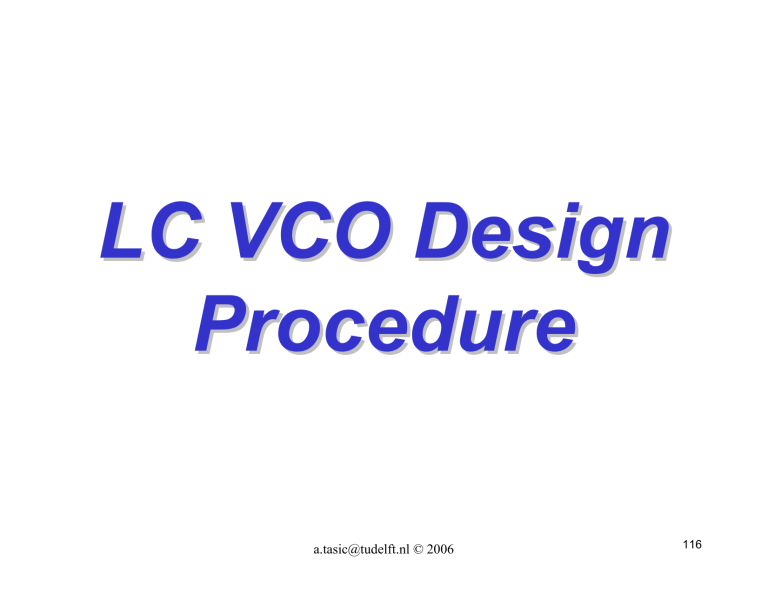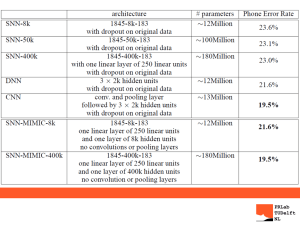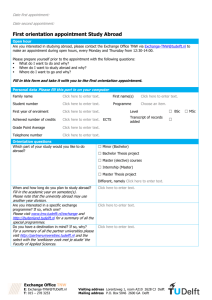LC VCO Design Procedure
advertisement

LC VCO Design Procedure a.tasic@tudelft.nl © 2006 116 UMTS VCO VCO design parameters Design requirement Oscillating frequency Tuning range Voltage swing Phase noise Supply voltage Power consumption 2.1GHz 400MHz 0.7V -110dBc@1MHz 3V 10mW Technology parameters Values Technology Number of metals Transit frequency MIM capacitors Varactors BiCMOS 4 50GHz available available WCDMA Specs Receiving Band (GHz) Channel Spacing (MHz) Multiplex / Modulation MDSeff (dBm) SNR (dB) / BER Processing Gain (dB) Tx-Rx Isolation (dB) Blocker @ 8MHz (dB) Value 2.11-2.17 5 (3.84) FDD / QPSK -99 7 / 1E-3 25 50 -46 L (8MHz)=-99-(-46)-10log(3.84e6)-7=-129dBc/Hz a.tasic@tudelft.nl © 2006 117 Series vs. Parallel Resonator • frequency f0=2.1GHz • desired signal power P=10mW RS L C QL=20 RTK C L • L=3nH, C=1.9pF, RS=2Ω • L=3nH, C=1.9pF, RTK=800Ω • fundamental current and voltage i=100mA, v=0.2V • fundamental current and voltage i=5mA, v=4V • very large current • moderate current and voltage • realistic choice a.tasic@tudelft.nl © 2006 118 Negative Resistance Oscillator ω0 = V CC C V L, RL CV 1 LC C = CV / 2 UT −gm / 2 Q1 resonating LC tank active part Q2 IC = I TAIL QCS IT 2 biasing current source QCS a.tasic@tudelft.nl © 2006 119 LC Tank Design • oscillation frequency f0 = 1 C = CV / 2 2π LC • determine L and C • tuning range f MAX = f MIN CV ,MAX CV ,MIN CV ,MAX C PAR +2 CV ,MIN CV ,MIN C 1 + 2 PAR CV ,MIN ⎛ f MAX = ⎜⎜ ⎝ f MIN • parasitics impose larger capacitive tuning range 2 ⎡⎛ f ⎞ ⎟ + 2⎢⎜ MAX ⎟ ⎜ f ⎢ ⎠ ⎣⎝ MIN 2 ⎤ C ⎞ ⎟ − 1⎥ PAR • determine CMAX and CMIN ⎟ ⎥ CV ,MIN ⎠ ⎦ a.tasic@tudelft.nl © 2006 120 How to Choose L? • tank conductance GTK • phase noise 1 ⎛ 1 1 ⎞ ⎜ ⎟ = + ⎜ ω 0 L ⎝ QL QC ⎟⎠ L( Δω ) ≅ • choice of L • larger L => larger QL R L + 2 RC ⎛ ω0 ⎞ ⋅ F⎜ KT ⎟ 2 VS ⎝ Δω ⎠ 2 • larger L => larger RL • larger L => lower GTK • larger L => poorer L • larger L => lower power consumption • larger L => lower fRES, fQ-PEAK • larger L => lower tuning range • choose for the largest L having peak Q close to the operating frequency a.tasic@tudelft.nl © 2006 121 How to Choose C? • phase noise • tank conductance GTK RL 2 = + 2 R ( ω C ) C 0 ( ω 0 L )2 L( Δω ) ≅ R L + 2 RC ⎛ ω0 ⎞ ⋅ F⎜ KT ⎟ 2 VS ⎝ Δω ⎠ 2 • choice of C • larger C => lower Q • larger C => larger GTK • larger C => lower RC • larger C => slightly better L • larger C => larger power consumption • larger C => larger tuning range • choose for C providing not more than the required frequency tuning range a.tasic@tudelft.nl © 2006 122 Active Part Design • chosen LC tank parameters determine losses to be compensated GTK = RL 2 + 2 R ( ω C ) C 0 ( ω 0 L )2 • cross-coupled pair conductance gM = gm / 2 • oscillation condition gM>GTK determines the very minimum compensating active-devices current ⎞ ⎛ RL 2 ⎜ I C = g mVT > 2GTK VT = 2⎜ + 2 RC ( ω 0C ) ⎟⎟VT 2 ⎠ ⎝ ( ω0 L ) • choose for the transistors having enough fT (~10f0) for the determined collector current a.tasic@tudelft.nl © 2006 123 What About Phase Noise? • there is nothing better than the best LC-tank • the best LC tank chosen determines power consumption and accordingly active devices operating current • shot noise is directly determined by operating current, i.e., LC tank • the larger the transistor the lower the base resistance thermal noise (but more parasitics) • choose for as large transistors as possible having enough fT (~10f0) for the determined collector current a.tasic@tudelft.nl © 2006 124 Tail Current Source • Tail current noise around even multiples of the oscillating frequency is transformed into the phase noise of the VCO • Tail current noise contribution larger than all other contributions together • Reducing the output noise power of the current source, its contribution to the phase noise is reduced as well • emitter degeneration reduces the tailcurrent source noise transfer functions • resistive degeneration effective at all frequencies but requires voltage headroom • inductive degeneration effective in narrow frequency band but requires no voltage headroom a.tasic@tudelft.nl © 2006 I CS, RID VB,CS QCS IB,CS IC,CS ZD 125 So Far VCO design parameters Design requirement Oscillating frequency Tuning range Voltage swing Phase noise Supply voltage Power consumption 2.1GHz 400MHz 0.7V -110dBc@1MHz 3V 10mW Technology parameters Values Technology Number of metals Transit frequency MIM capacitors Varactors BiCMOS 4 50GHz available available a.tasic@tudelft.nl © 2006 126 Simulations/ Layout/ Measurements a.tasic@tudelft.nl © 2006 127 Design Procedure • Calculations • estimation of design parameters • Simulations • Layout • Measurements a.tasic@tudelft.nl © 2006 128 Simulations • Simulation with estimated idealized components • adjustment of estimated design parameters • Simulation with components’ models provided by technology • adjustment of estimated design parameters a.tasic@tudelft.nl © 2006 129 Layout • Layout design • Layout extraction • Postlayout simulation • adjustment of circuit and layout parameters • Layout verification • design rules check • layout versus schematic check a.tasic@tudelft.nl © 2006 130 Measurements (Design Verification) • Chip packaging • Printed Circuit Board design • Measurement setup • Simulation of measurement setup • IC-package-PCB • Interpretation of measured results a.tasic@tudelft.nl © 2006 131 VCO Design Example Simulations a.tasic@tudelft.nl © 2006 132 Idealized VCO Schematic VCC L CV CV • L=3nH, QL=25, CV0=3.8pF UT • CA=150fF, CB=600fF CB Q1 CA CB RB RB VB ITAIL Q2 • collector current (0.2mA, 3mA) • transistor dimensions 0.5x10um2 CA • tail current (0.4mA, 6mA) QCS QCS LRID LRID • TCS transistor dimensions 0.5x20um2 • LRID=3.4nH a.tasic@tudelft.nl © 2006 133 VCO Schematic with Inductor Model VCC CL L /2 CL R L /2 C OX C R SUB SUB CV RC R L /2 L/2 C SUB C OX R SUB • L=3nH • n=3, w=20um CV RC UT • dOUT=320um, s=5um CB Q1 CA CB RB RB VB Q2 CA • LRID=3.4nH • n=6, w=7um ITAIL QCS QCS LRID • dOUT=120um, s=1um LRID a.tasic@tudelft.nl © 2006 134 VCO Design Example Layout a.tasic@tudelft.nl © 2006 135 Layouting • Components placement and routing • Chip padding • Isolation • guard rings • Protection • Electrostatic Discharge (ESD) • Substrate contacts, metal distribution a.tasic@tudelft.nl © 2006 136 VCO Layout – Top View bond pad LRID -gM C L LRID a.tasic@tudelft.nl © 2006 137 Placement • Generation of component layouts • Component Separation • sensitive I/O nodes (RF/LO) • sensitive circuits (power amplifiers/oscillator) • sensitive sub-systems (analog/digital) • Component coupling • substrate, interconnects, bondwires a.tasic@tudelft.nl © 2006 139 Routing • Track width/length • thick(wide)/long/top • thin(narrow)/short/bottom • Current density • wide ground/supply lines • Bottom metal component interconnect • Top metal circuit/system interconnect a.tasic@tudelft.nl © 2006 140 Padding • IC interface • inputs/outputs – information signal lines • bias lines – supply, ground • Area increase • size 100x100um2 • distance 100um • ESD for sensitive nodes • HF circuit performance degradation • capacitance added a.tasic@tudelft.nl © 2006 141 Design Rules (Layout Verification) • • • • • • • Component size (width/length) Component spacing Track width Track spacing Metal density Geometry Grid a.tasic@tudelft.nl © 2006 142 Design Rule Compliant VCO Layout • Design Rule Check (DRC) • Comparison of layout and schematic (LVS) • Generation of output file for fabrication (GDSII) a.tasic@tudelft.nl © 2006 143 VCO Design Example Measurements a.tasic@tudelft.nl © 2006 144 Chip and Measurement Equipment Interface a.tasic@tudelft.nl © 2006 145 Verification Procedure • Oscillator chip packaging • Oscillator IC Printed Circuit Board design • Measurement setup • Interpretation of the results a.tasic@tudelft.nl © 2006 146 VCO Chip Microphotograph LRID -gM C L LRID a.tasic@tudelft.nl © 2006 147 Packaged VCO IC VCO chip bondwire bondpad a.tasic@tudelft.nl © 2006 149 Packaged VCO IC on PCB SMD transformer SMD resistor VCO IC package bias choke a.tasic@tudelft.nl © 2006 SMD inductor SMD capacitor 150 Measurement Fixture I/O connectors transformer bias filtering VCO IC bias filtering package PCB a.tasic@tudelft.nl © 2006 151 Package and PCB Effects • Measured vs. simulated • Include into simulations • bondwire inductance • package lead inductance • contact capacitances • SMD components on PCB • transmission lines on PCB toPCB CPCB LBW LPKG CPKG toVCO CBPAD a.tasic@tudelft.nl © 2006 152 Measurement System VCC-XF Spectrum analyzer VVCO + + VCC + + LO test fixture + UTUNE IBUFFER VVCO ITAIL VCC IBUFFER a.tasic@tudelft.nl © 2006 153 Measured Signal Spectrum signal power signal frequency a.tasic@tudelft.nl © 2006 154 Measured Frequency Tuning Range • fLOW=1.8GHz • fUP=2.4GHz • Δf=600MHz • VTUNE=3V 2,5 Oscillating frequency [GHz] 2,4 VCC=3V 2,3 2,2 2,1 2 1,9 1,8 1,7 0 0,5 1 1,5 2 2,5 3 Tuning voltage VT [V] a.tasic@tudelft.nl © 2006 155 Measured Phase Noise PN(1MHz)=-110dBc@3mW a.tasic@tudelft.nl © 2006 156 Measured VCO Performance VCO design parameters Measurement Results Central frequency 2.1GHz Tuning range 600MHz Voltage swing 0.7V Phase noise -110dBc@1MHz Supply voltage 3V Power consumption 3mW a.tasic@tudelft.nl © 2006 157 Conclusions a.tasic@tudelft.nl © 2006 159 So far • Oscillator classification • Oscillation condition – frequency, amplitude • Oscillator phase noise • UMTS oscillator design – estimation, simulation, layout, measurements a.tasic@tudelft.nl © 2006 160 Job Offer • RF/analog circuits design experience • oscillators • CAD design • Cadence, ADS • Measurements and PCB design • Salary 60.000 a.tasic@tudelft.nl © 2006 161




